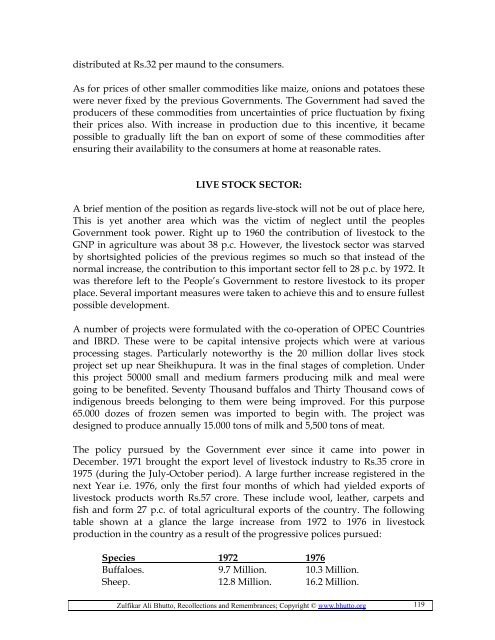Zulfikar Ali Bhutto Recollections and remembrances
Zulfikar Ali Bhutto Recollections and remembrances
Zulfikar Ali Bhutto Recollections and remembrances
Create successful ePaper yourself
Turn your PDF publications into a flip-book with our unique Google optimized e-Paper software.
distributed at Rs.32 per maund to the consumers.As for prices of other smaller commodities like maize, onions <strong>and</strong> potatoes thesewere never fixed by the previous Governments. The Government had saved theproducers of these commodities from uncertainties of price fluctuation by fixingtheir prices also. With increase in production due to this incentive, it becamepossible to gradually lift the ban on export of some of these commodities afterensuring their availability to the consumers at home at reasonable rates.LIVE STOCK SECTOR:A brief mention of the position as regards live-stock will not be out of place here,This is yet another area which was the victim of neglect until the peoplesGovernment took power. Right up to 1960 the contribution of livestock to theGNP in agriculture was about 38 p.c. However, the livestock sector was starvedby shortsighted policies of the previous regimes so much so that instead of thenormal increase, the contribution to this important sector fell to 28 p.c. by 1972. Itwas therefore left to the People’s Government to restore livestock to its properplace. Several important measures were taken to achieve this <strong>and</strong> to ensure fullestpossible development.A number of projects were formulated with the co-operation of OPEC Countries<strong>and</strong> IBRD. These were to be capital intensive projects which were at variousprocessing stages. Particularly noteworthy is the 20 million dollar lives stockproject set up near Sheikhupura. It was in the final stages of completion. Underthis project 50000 small <strong>and</strong> medium farmers producing milk <strong>and</strong> meal weregoing to be benefited. Seventy Thous<strong>and</strong> buffalos <strong>and</strong> Thirty Thous<strong>and</strong> cows ofindigenous breeds belonging to them were being improved. For this purpose65.000 dozes of frozen semen was imported to begin with. The project wasdesigned to produce annually 15.000 tons of milk <strong>and</strong> 5,500 tons of meat.The policy pursued by the Government ever since it came into power inDecember. 1971 brought the export level of livestock industry to Rs.35 crore in1975 (during the July-October period). A large further increase registered in thenext Year i.e. 1976, only the first four months of which had yielded exports oflivestock products worth Rs.57 crore. These include wool, leather, carpets <strong>and</strong>fish <strong>and</strong> form 27 p.c. of total agricultural exports of the country. The followingtable shown at a glance the large increase from 1972 to 1976 in livestockproduction in the country as a result of the progressive polices pursued:Species 1972 1976Buffaloes. 9.7 Million. 10.3 Million.Sheep. 12.8 Million. 16.2 Million.<strong>Zulfikar</strong> <strong>Ali</strong> <strong>Bhutto</strong>, <strong>Recollections</strong> <strong>and</strong> Remembrances; Copyright © www.bhutto.org 119


